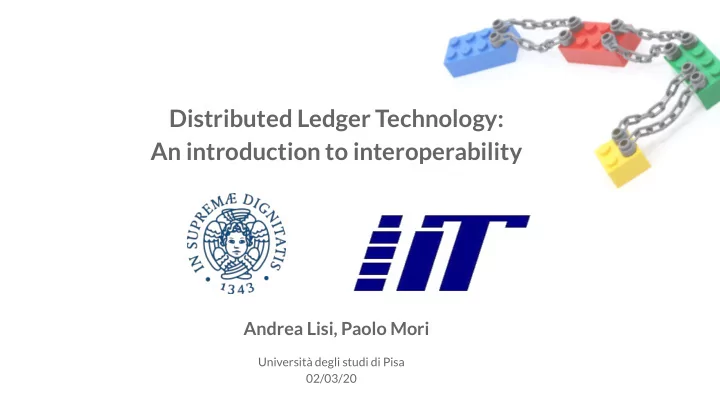

Distributed Ledger Technology: An introduction to interoperability Andrea Lisi, Paolo Mori Università degli studi di Pisa 02/03/20
2009 2
2009 3
2009 Bitcoin is a P2P payment system where nodes share the ledger of money Transactions, the Blockchain The ledger is updated by the first node solving a hash search puzzle, Proof-of-Work (PoW), and gets rewarded with new coins 4
Bitcoin Transactions are secured by cryptography, i.e. they cannot be (easily) modified: Immutability Transactions are visible by design: Transparency Transactions are ordered , i.e. it is possible to rebuild the current state of the ledger User are pseudo-anonym 5
Bitcoin 6
Bitcoin It is not intuitive for end users: it is easy to lose coins Slow processing power: around 7 Txs / s Bitcoin is a good protocol as a decentralized payment system, but not much more 7
Bitcoin - Monolithic Images from: https://cosmos.network/intro 8
2015 9
2015 Ethereum is a global, open-source platform for decentralized applications Ethereum nodes run a virtual machine (EVM) that allows the execution of Turing-complete software called Smart Contracts 10
Ethereum Smart contracts expose Functions which can modify a State stored in such contracts With respect to Bitcoin, is possible to create more complex applications, also known as Decentralized Applications (DApp) Because Smart contracts are executed by the ● whole network 11
Ethereum A very popular DApp is called Cryptokitties, a marketplace of digital cats with unique traits Its popularity caused a network slowdown in ● December 2017 Cryptokitties smart contract: https://etherscan.io/token/0x06012c8cf97bead5deae237070f9587f8e7a266d 12
Ethereum Slow processing power, around 15 Txs / s Smart contracts bugs cannot be fixed and can lead to big money loss In 2016 3.6M ETH were stolen, the equivalent of ● 70M $ (DAO attack) Less specialized than Bitcoin, but all DApps share the same resources 13
Ethereum - A top layer Images from: https://cosmos.network/intro 14
2019 15
2019 16
2019 Blockchain applications are self-contained Bitcoin is specialized in digital payments ● Ethereum allows general DApps, but with shared ● resources And more... ● Can they interact? 17
Use cases Cross-chain asset exchange Without relying on trusted third parties ● Cross-chain asset portability Move an asset between chains ● Cross-chain smart contract interaction Smart contracts can trigger operations on other ● chains 18
Notary schemes A trusted party, notary, is able to interact with two chains, X and Y Example: a listener fires a callback on X when ● detects a particular event on Y Most intuitive approach, but introduces a single point of failure 19
Side-chains A chain can validate the state transitions of other chains This approach is hard to achieve: it requires a blockchain, a self-contained system, to access to the outside world Otherwise, the input data must be provided by ● an external user 20
Hash locking Operations on different chains have the same trigger Typically, the preimage of an hash value ● This approach is easy to implement and does not require external data But its applicability is limited with respect to the ● other approaches 21
Connecting chains Images from: https://cosmos.network/intro 22
Future steps Investigate more in depth the approaches and the use cases Propose an interoperability solution for a particular use case, either modifying an existing technology (if feasible) or provide an original proof of concept In the past I worked on a notary scheme solution ● 23
Thank you!
References - Bitcoin Bitcoin: A peer-to-peer electronic cash system , S Nakamoto https://bitcoin.org/en/blockchain-guide Mastering Bitcoin , M. Antonopoulos 25
References - Ethereum Ethereum: A secure decentralised generalised transaction ledger , G Wood https://blog.openzeppelin.com/ethereum-in-depth-part-1-968981e6f833/ A survey of attacks on ethereum smart contracts , N. Atzei, M. Bartoletti T. Cimoli 26
References - Interoperability Chain Interoperability , V. Buterin Assessing interoperability solutions for distributed ledgers , T. Koens , E. Poll Anonymous Multi-Hop Locks for Blockchain , G. Malavolta, P. Moreno-Sanchez, C. Schneidewind, A. Kate, M. Maffei Interledger Approaches , V. A. Siris, P. Nikander, S. Voulgaris, N. Fotiou, D. Lagutin, G. C. Polyzos Atomic Cross-Chain Swaps , M. Herlihy 27
References - Technology Bitcoin Lightning Network: https://lightning.network/ BTCRelay (deprecated): http://btcrelay.org/ Cosmos: https://cosmos.network/ Polkadot: https://polkadot.network/ Interledger: https://interledger.org/ 28
Recommend
More recommend